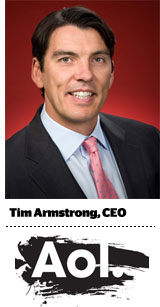 In Q2, as it has for the past year, AOL’s third party network revenue rose by double digits, while U.S. display dollars remained flat. Read the earnings release.
In Q2, as it has for the past year, AOL’s third party network revenue rose by double digits, while U.S. display dollars remained flat. Read the earnings release.
During the earnings call with investors, who once again saw their low expectations exceeded by AOL’s performance, CEO Tim Armstrong batted back questions about the advertising challenge from Google and Facebook, both of which are battling it out for the biggest piece of the display pie. In a bid for greater patience that the turnaround strategy will work, Armstrong outlined the missteps and attempts to address them over the past 12 months.
“Our approach to the marketplace last year was not data-centric and non-verticalized,” Armstrong said. “We have shifted that back and spent a lot of time with clients and agencies. My rule now is that you can’t leave the building without data. And that data has to be transformational [in] how it goes across our products and services.”
Here are some of the highlights from AOL’s Q2:
— Total advertising revenue was up 6 percent, for its fifth consecutive quarterly rise.
— Global display revenue was up 2 percent, though U.S. display was exactly flat, as international jumped 21 percent.
— There was 9 percent year-over-year growth in combined AOL Properties Display and Third Party Network revenue, which totaled $251.3 million for the quarter. By itself, third party network revenue gained 19 percent, which was primarily attributed to the inclusion of Ad.com’s Japan dollars.
— Q2 saw the lowest rate of search and contextual revenue decline in over three years of 1 percent, thanks to double digit growth in search revenue on AOL.com.
— The number of advertisers buying Project Devil ads grew by “triple digits” year-over-year. Over half of Project Devil advertisers in Q1 2012 repurchased ad in Q2.
Total revenues were down 2 percent, dragged down by subscription declines.
In trying to explain the flatness in the U.S., Armstrong was asked if advertisers are pulling back on spending and whether more is going toward social media and away from portals and content sites. In other words, was AOL fated to lose against the rise of Google and Facebook?
“The differentiator for AOL is focus on the format side,” Armstrong said. “The second piece is how do you fit the ad network system into the overall ad market, essentially, Google has an end to end platform and we probably have the second largest tech stack. Once you drop below that, you start to see this massive checkerboard of individual companies and properties. There are very few entities that have scale across the board. We bring large scale in tech in terms of planning and targeting, and differentiation in the formats, like Devil, that we provide. We not only have our own business, targeting and analytics, we are also able to go into other exchanges and buy that way as well.”
Still, it will take a bit more than merely shifting its focus to data and RTB environments.
As eMarketer noted, U.S. online advertising spending in Q2 2012 grew 23.8 percent to $9.51 billion since last year, while AOL’s share of that market declined to 2.8 percent in 2011, down from 3.4 percent in 2010. While the online advertising market is expected to grow 23.3 percent to $39.5 billion this year, AOL’s share of revenues will fall further to 2.4 percent. Google, by comparison, is expected to see its share grow to 16.5% this year, up from 13.8 percent a year ago.
Overall, the display advertising market in the US is expected to grow 24.1 percent to $15.3 billion in 2012, eMarketer is projecting.











